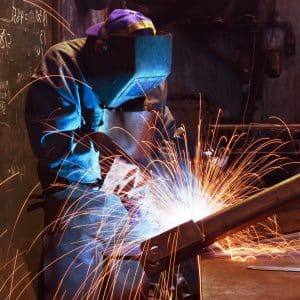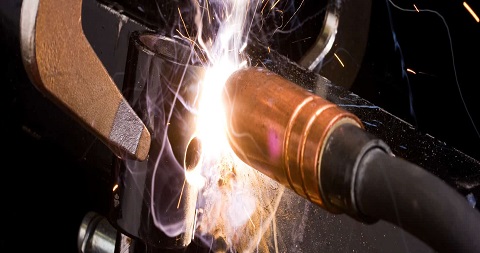Welding is a process that can be described as joining two different materials together, of which there are various different types of welding. The materials used in most types of welding are commonly metal, and both heat and pressure are used to help make the materials more malleable or soft, so they can become joined or forged.
Welding dates back to the Middle Ages, although the modern method that we know did not come about until the 19th-Century. In the modern world, welding is a skilled role and one that covers many areas, whereby welders utilise different methods that form part of the welding process. It’s a varied craft, and one that now relies on skill and technology to undertake correctly.
The many types of welding use a technique that is commonly used by professional welders and although it is not a new process, it requires the right tools and metals to ensure a successful job is completed. As metals are solid materials, working with them can prove challenging, but welding makes this possible and that means that welders can transform any piece into a shape or design. Despite this, welding is not something that anyone can pick up because it requires training, skill and an understanding of how each welding process works.
To many, welding might seem as though it always consists of the same thing, but this is not the case, as there are more than 30 different types. There are four main types of welding. Tungsten Inert Gas (TIGW) Welding, Metal Inert Gas (MIG) Welding, Shielded Plasma Metal Arc Welding, and Flux Cored Arc Welding (FCAW).
However, they are all unique, and they are all used for certain purposes, so we are going to delve into the main types below and show you why they are used.
Different Types of Welding and What are They Used for?
Plasma Arc Welding

MIG Welding (Metal Inert Gas)
This type of welding is used when the materials being welded are fragile or delicate and have to be protected from the damaging effects of the welding process, although this does not include the process of joining. It is also a technique that is used should the job need to be completed quickly. During this process, a gas is used as this helps to create a protective shield for the weld metal, protecting it from natural elements such as oxygen. This makes it possible for the welder to weld at a continuous rate because the shielding ensures no damage is caused. Just like arc welding, there are many forms of MIG welding, such as Synergic MIG.
TIG Welding (Tungsten Inert Gas)
TIG welding, which is also known as gas tungsten arc welding (GTAW). This form of welding is much like MIG welding, although it uses a tungsten current form as opposed to a metal electrode that MIG uses. Here you can find help if you want to know the average cost to build an addition and to get in touch with the latest trends in the room addition industry in RI. The use of tungsten is mainly down to the way in which it can handle higher temperatures than many other materials before it reaches melting point. However, an additional filler is required and this is used inside the welding equipment. This is a form of welding that is commonly used in those industries that use stainless steel. Once again, this welding technique have a number of sub-categories and this can include the likes of Synergic TIG, Heavy TIG and Hot-Wire Automatic TIG.
Plasma Transferred Arc
Plasma transferred arc welding (PTAW) is a welding technique that uses a plasma torch to generate a high-energy plasma arc that melts the welding material. The welding process is similar to gas tungsten arc welding (GTAW), but the plasma arc is transferred through a small nozzle to the workpiece, providing a higher energy density and a faster melting rate. This allows PTAW to be used for welding materials that are difficult to weld with other methods, such as high-strength steels, titanium, and other refractory metals. PTAW is also well suited for the repair of large and complex parts, as well as for the fabrication of new components. One of the main advantages of PTAW is that it can be used to weld in any position, making it an ideal choice for welding in hard-to-reach areas. PTAW also offers a very high deposition rate, which means that welding can be done quickly, reducing the overall cost of the process.
Synergic Mig
Synergic MIG welding is a type of welding that utilises a combination of both synergic and pulse welding techniques. In this process, the welder sets the desired welding parameters, such as wire feed speed and voltage, and the welding power source automatically adjusts the output to match those settings. This eliminates the need for manual adjustments and allows for a more consistent and efficient welding process. The pulse feature in synergic MIG welding also improves weld quality by reducing spatter and heat input, resulting in a smoother and stronger final weld. Additionally, it’s often used in the manufacturing of automobiles, appliances, and construction materials. Synergic MIG welding is considered a cost-effective and efficient method of welding, making it popular in industrial and manufacturing settings.
Submerged Arc Welding and Deposition
Submerged Arc Welding (SAW) is a type of welding that utilises a consumable electrode that is continuously fed through a welding gun and into the weld joint. The electrode and the weld joint are covered with a layer of granular flux, which protects the weld from oxidation and contamination. The flux also generates a slag that covers the weld, which must be removed after welding. The use of the flux and the submerged arc technique provides for deep penetration of the weld and high quality weld deposit.
Deposition in Submerged Arc Welding refers to the process of adding metal to the weld joint. This is done by using a consumable electrode that is continuously fed through the welding gun and into the joint. The electrode is melted and deposited into the joint, filling any gaps and creating a strong bond between the two pieces of metal. The deposited metal is referred to as the “weld deposit” or “weld metal”. Deposition rate in SAW is generally high, and it’s commonly used in heavy industries like shipbuilding, bridge construction and pipe welding, where large metal parts must be joined together.
Through to Synergic Tig
Synergic TIG welding, also known as pulse TIG welding, is a type of TIG welding that utilises a combination of both synergic and pulse welding techniques. In this process, the welder sets the desired welding parameters, such as amperage and pulse frequency, and the welding power source automatically adjusts the output to match those settings. This eliminates the need for manual adjustments and allows for a more consistent and efficient welding process. The pulse feature in synergic TIG welding also improves weld quality by reducing heat input and warping, resulting in a smoother and stronger final weld.
In Synergic TIG welding, a constant current power source is used to create an electric arc between the tungsten electrode and the workpiece. The arc is used to heat and melt the metal, which is then deposited into the joint. The TIG process is more precise and provides more control than other welding methods, making it ideal for applications that require high precision and quality welds. Synergic TIG welding is often used in aerospace, medical, and electronic industries where the highest level of quality and precision is required.
MMA Welding
MMA welding, also known as stick welding, is a type of arc welding that uses a consumable electrode coated in flux to lay the weld. The electrode is held in an electrode holder, and when it’s brought into contact with the workpiece, an electric arc is struck between the electrode and the workpiece. The heat generated by the arc melts the electrode and the workpiece, creating a pool of molten metal. The electrode is then gradually fed into the pool as it melts, which provides filler metal for the weld. The flux coating on the electrode also shields the arc and the molten metal from the atmosphere, preventing oxidation and contamination. MMA welding is a versatile, reliable and cost-effective welding process that can be used in many fields, such as construction, repair, fabrication, and maintenance.
Plasma Cutting and Fusion
Plasma cutting is a process that uses a high-speed stream of ionised gas (plasma) to cut through electrically conductive materials, such as metals. The plasma is created by heating a gas, such as air or argon, with an electric arc. The plasma is then directed through a small nozzle, which concentrates the plasma stream and increases its cutting speed and precision. Plasma cutting can be used to cut various thicknesses of metal, and it is faster and more precise than traditional cutting methods such as oxygen cutting.
Fusion welding is a welding process that creates a weld by heating the two pieces of metal to a point where they melt and fuse together. The process of fusing the two pieces of metal together is known as fusion. In plasma welding, a plasma torch is used to heat the metal and create the weld. The plasma torch produces a high-temperature plasma arc that melts the metal, and the resulting puddle is fused by the application of pressure or by the use of a filler material. Plasma welding is typically used in industries where high-quality and precision welding is required, such as aerospace, automotive, and electronic industries.
Power Welding
Power welding is a broad term that refers to the use of electrical power to create heat and join metal pieces together. There are many types of power welding, including arc welding, resistance welding, and laser welding. Each type of power welding uses a different method to generate heat and create the weld. For example, arc welding uses an electric arc to heat the metal, while resistance welding uses an electric current to heat the metal through resistance. Laser welding uses a focused beam of high-energy light to melt the metal. Power welding is widely used in many industries, including construction, manufacturing, and automotive. It is known for its speed, accuracy, and cost-effectiveness.
Overlaying
Overlay welding is a process of applying one or more layers of weld metal over the surface of a base metal. This technique is used to improve the wear resistance, corrosion resistance, or other properties of the base metal. Overlay welding can be performed using various welding methods such as TIG, MIG, SMAW and FCAW. The overlay material used is typically a higher alloy content than the base metal. The overlay is applied in a series of passes, each pass depositing a specific thickness of overlay material. The overlay material can also be applied in a specific pattern, such as a criss-cross pattern, to improve the wear resistance in a specific area. Overlay welding is widely used in industries such as mining, oil and gas, and power generation where high wear and corrosion resistance is required.
What is the Strongest Type of Weld?

What is the Best Welder for a Beginner?
When it comes to welding as a beginner, the best welder to start with is a stick welder (MMA welding) or a wire feed welder (MIG welding). These types of welders are relatively easy to use and are suitable for a wide range of welding applications, from simple home repairs to light fabrication projects.
A stick welder is a cost-effective, portable and versatile welding machine that uses a consumable electrode coated in flux to lay the weld. It is relatively simple to operate and is ideal for welding thicker materials or in outdoor environments.
A MIG welder (metal inert gas) is also a good choice for beginners because it is easy to use, less expensive and has a wide range of welding applications from light fabrication to heavy repair work. MIG welding uses a wire feeder that continuously feeds wire through a gun, which is then used to create a weld. It is generally easier to learn than TIG welding, and it’s also less expensive.
Welding Types to Use for the Process
At this point, you should now have a clearer understanding of what welding is and how the welding techniques are used. Of course, as we touched on, there are more than 30 different types and the methods above almost form an umbrella for the many types of welding that fall within them. Welding can be used for a whole range of applications, but it requires the expertise of a welder to ensure that it is performed correctly, safely and with precision. To achieve this, it requires the right personnel and the latest equipment.
To learn more about our range of welding services and which type of welding that is suitable for your requirements, you can get in touch with us and let us help you make an informed decision.
Conclusion
As you can see, there are many welding types to consider. It does help to know what are the differences between them to help you determine which is right for you. Whether you need MIG welding machines or another type of system, now you can make an informed decision based on your exact requirements.

